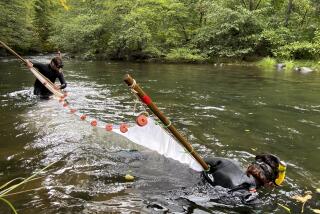Salmon Run to the Market
In 1983, seafood marketer Jon Rowley brought down 300 pounds of Alaskan salmon from the Copper River and sold it to four Seattle restaurants. Fifteen years later, the harvest is predicted to be close to 18 million pounds and it will be distributed all over the country.
So successful was the promotion that there is now a Nouveau Beaujolais-style competition among seafood markets to be the first to offer the fish.
âIt used to be in the mid-â80s that we would do well to have 700,000 to 800,000 fish,â says Slim Morstad of the Alaska Department of Fish and Game. âWell, in the â90s, weâve only had two years below 1 million.â
This yearâs projection is for 1.9 million sockeye and 50,000 kings. The gain not only is a boon for fish eaters, it also reflects an improvement in the ecology of Alaskan salmon waters.
âWith a fishery this size, it doesnât take much of an improvement to make a big difference in the catch,â Morstad says. âIf you can increase the survivability by 1%, that means a lot more fish.â
âBasically this just goes to show you what is going on with this habitat,â says Rowley. âTheyâve got a pristine watershed up there and they have a system thatâs in great shape. And Fish and Game does a real good job of managing the fishery.â
Copper River salmon is famous for its high fat content, deep nutty flavor and intense color. âItâs a really lurid orange,â Rowley says, âlike carnival glass or something.â
In Seattle, which remains salmon central, Rowley says that the fish has become so popular it irritates some of the more creative chefs. âYou go in their restaurants and you see orange on every plate,â he says. âIn some of those places it accounts for 60% of the menu sales, and those guys get tired of just grilling salmon all day.â
The Copper River season, which began last week, is the first salmon run of the year in Alaska. Its success has spawned similar appellation-labeled marketing efforts, including those in Kodiak, Yukon River and Bristol Bay. Those start in June. The total salmon harvest in Alaska this year is projected to top 145 million fish, up from 123 million last year.
Copper River salmon are available in Southern California at the three Santa Monica Seafood stores, at Fish King in Glendale and at various Bristol Farms supermarkets.
FARMERSâ MARKET REPORT
Early spring may have dragged itself into the farmersâ markets reluctantly, but late spring arrived with a bang last week. At the Long Beach downtown farmersâ market Friday, Tamai Farms from Oxnard and Wong Farms from the Salton Sea area had good-looking tomatoes, Rancho Vera in Vista had corn and melons, Lister Farms near Exeter had the first Burlat cherries, and Zamora Produce from Vista had all kinds of squash--green, gray and gold zucchini as well as yellow crookneck and pattypan. Of course, there were early-spring favorites around too. Weyser Farms from Tehachapi has fingerling, purple Peruvian, Yukon gold and baby red potatoes; Top Veg, which still farms in the Carson area, had all kinds of lettuces and greens, including frisee, shingiku (chrysanthemum leaves), dandelions, red kale and a Japanese green they just call âhalf spinach, half mustardâ; Green Farms from near Lompoc had artichokes and asparagus; and ABC Rhubarb, which farms in the Downey-Bell Garden area, had rhubarb as well as all kinds of herbs. Old favorite Harryâs Berries is there with its Chandler and Seascape strawberries, and Santa Barbara fish dealer Pete Siracusa had sand dabs, ahi tuna, true Gulf snapper from Baja, California halibut, barracuda and scallops.
More to Read
Sign up for The Wild
Weâll help you find the best places to hike, bike and run, as well as the perfect silent spots for meditation and yoga.
You may occasionally receive promotional content from the Los Angeles Times.







